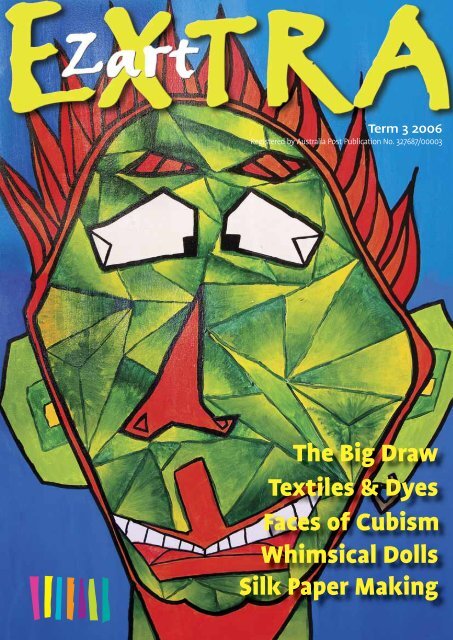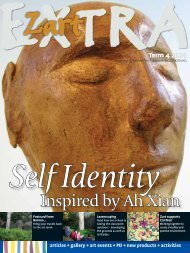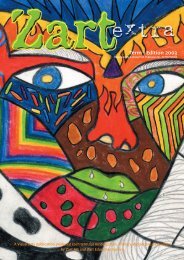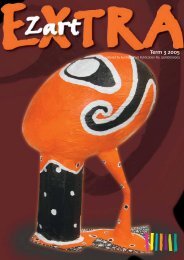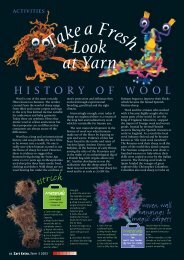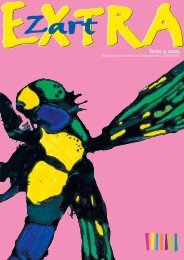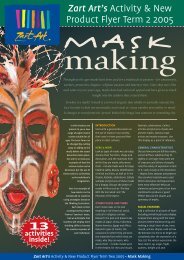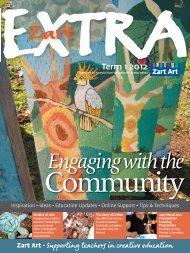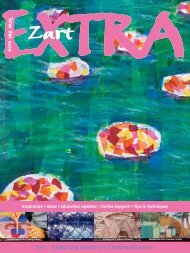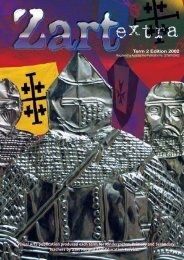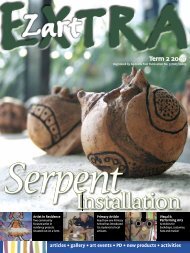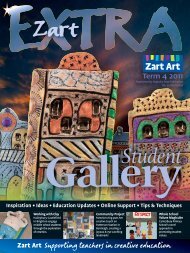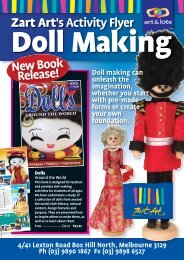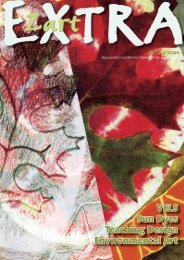Faces of Cubism Textiles & Dyes Silk Paper Making ... - Zart Art
Faces of Cubism Textiles & Dyes Silk Paper Making ... - Zart Art
Faces of Cubism Textiles & Dyes Silk Paper Making ... - Zart Art
Create successful ePaper yourself
Turn your PDF publications into a flip-book with our unique Google optimized e-Paper software.
Term 3 2006 2005<br />
Registered by Australia Post Publication No. 327687/00003<br />
The Big Draw<br />
<strong>Textiles</strong> & <strong>Dyes</strong><br />
<strong>Faces</strong> <strong>of</strong> <strong>Cubism</strong><br />
Whimsical Dolls<br />
<strong>Silk</strong> <strong>Paper</strong> <strong>Making</strong>
contents primary article cont<br />
cover +<br />
page 3<br />
Primary <strong>Art</strong>icle:<br />
<strong>Faces</strong> <strong>of</strong> <strong>Cubism</strong><br />
Brentwood Park<br />
Primary School<br />
page 4<br />
Pr<strong>of</strong>ile:<br />
A New Chapter in the<br />
History Of Heide Museum<br />
<strong>of</strong> Modern <strong>Art</strong><br />
page 5<br />
“With the Big Draw we seem to have<br />
struck something in the national<br />
consciousness - it’s as though<br />
everybody had just been waiting<br />
to be told that they are allowed<br />
to draw. Perhaps it isn’t surprising<br />
- we live under a bombardment <strong>of</strong><br />
manufactured images, and in the face<br />
<strong>of</strong> that we need to be able to draw as<br />
a way <strong>of</strong> discovering the reality <strong>of</strong> the<br />
world about us, as well as the life in<br />
ourselves”<br />
- Quentin Blake, English illustrator<br />
<strong>Zart</strong>'s Student Gallery<br />
What's on & featuring in<br />
our Gallery for Term 3 2006<br />
page 6<br />
Secondary <strong>Art</strong>icle<br />
Whimsical Dolls<br />
Killester College<br />
Everyone should be encouraged to<br />
draw. Drawing Australia is founded on a<br />
teaching and research program at Macquarie<br />
University, Sydney and it explores ways in<br />
which people <strong>of</strong> all ages, cultures and abilities<br />
can participate in our visual culture. It<br />
encourages everyone to draw and to organise<br />
special drawing events. To this end, Drawing<br />
Australia is organising another Big Draw<br />
from 3rd September to 15th October, 2006.<br />
By visiting their website www.aces.<br />
mq.edu.au/drawingaustralia you are able to<br />
register your Big Draw program.<br />
The Big Draw originates from the U.K.<br />
where a campaign for drawing was launched<br />
in 2000 by The Guild <strong>of</strong> St George, a small<br />
charity founded by John Ruskin, the great<br />
Victorian artist, writer and visionary. Ruskin<br />
saw drawing as the basis <strong>of</strong> visual thought.<br />
His mission was not to teach people how to<br />
draw, but how to see.<br />
New Products<br />
<strong>Textiles</strong> & <strong>Dyes</strong><br />
Activity:<br />
<strong>Making</strong> <strong>Silk</strong> <strong>Paper</strong>!<br />
The quick & easy way to<br />
make silk paper and wow<br />
look at the results!!<br />
The Big Draw Australia:<br />
3rd September - 15th October<br />
page 9<br />
page 10<br />
page 12<br />
The Big Draw is now in its sixth year in the<br />
U.K. and it has galleries, museums, science<br />
centres, heritage and environmental sites,<br />
libraries, archives, communities and shopping<br />
centres, colleges, schools and art clubs hosting<br />
drawing sessions for all ages. They explore<br />
technical, scientific, architectural, and<br />
archaeological or fine art drawing.<br />
Participants are invited to help expand<br />
the definitions and uses <strong>of</strong> drawing<br />
- experimenting with pencils, crayons,<br />
charcoal, sand, clay, digital imagery,<br />
choreographed movement, vapour trails and<br />
fire sculptures. See www.drawingpower.org.<br />
uk<br />
In Term 3, <strong>Zart</strong> <strong>Art</strong> will <strong>of</strong>fer three<br />
workshops to inspire and support you to bring<br />
The Big Draw to your school or classroom.<br />
Please see the <strong>Zart</strong> Workshop details.<br />
New Resources<br />
<strong>Silk</strong> paper making, to<br />
design and colour.<br />
ZART EXTRA<br />
A Visual <strong>Art</strong>s<br />
publication<br />
produced each<br />
term for<br />
Pre-school,<br />
Primary &<br />
Secondary<br />
Teachers by<br />
<strong>Zart</strong> <strong>Art</strong> and<br />
<strong>Zart</strong> Education<br />
Service.<br />
ISSN 1448—8450<br />
What’s Happening at<br />
<strong>Zart</strong> <strong>Art</strong> term 3 2006:<br />
Thanks for coming to the<br />
<strong>Zart</strong> Annual Expo. We hope<br />
you enjoyed your bargains<br />
and had the chance to<br />
participate in our free<br />
workshops and product<br />
demonstration throughout<br />
the day. See you all again next<br />
year.<br />
Pr<strong>of</strong>essional development<br />
@ <strong>Zart</strong> :This term Zes is<br />
focussing on the Big Draw.<br />
For more information see<br />
the above blurb or refer to<br />
our PD insert to find out<br />
how you can participate in<br />
the program. Our Book week<br />
workshops are still being<br />
run this term. Book week<br />
is celebrated from the 19th<br />
- 25th August 2006 with the<br />
winners <strong>of</strong> Book <strong>of</strong> the year<br />
announced on August 18<br />
2006. if you can't attend one<br />
<strong>of</strong> our workshops, our full<br />
colour <strong>Art</strong> and literature<br />
Book "Book Now! is currently<br />
available, overflowing<br />
with great activities and<br />
information on book week<br />
and the shortlisted books.<br />
it's beginning to look a lot<br />
like Christmas... it's that time<br />
<strong>of</strong> year again and we are<br />
launching our Christmas<br />
2006 Workshops- on the 27th<br />
<strong>of</strong> September! Come along<br />
and join in all the festive fun<br />
as we celebrate that classic<br />
tale "The Nutcracker". See our<br />
website or our PD Insert for<br />
dates & booking information.<br />
Speaking <strong>of</strong> Christmas, our<br />
2006 Christmas Catalogue<br />
is coming out to you in mid<br />
july. Inside you'll find a great<br />
range <strong>of</strong> festive products,<br />
super saving specials & plenty<br />
<strong>of</strong> activities!<br />
<strong>Zart</strong> Extra<br />
This publication is sent out to all<br />
schools in the first week <strong>of</strong> each<br />
term. This newsletter allows art<br />
teachers/co-ordinators to learn<br />
about what is happening in<br />
art education and what other<br />
art teachers are doing. You will<br />
find information on new art<br />
techniques and processes, the<br />
latest materials and resources<br />
on the market. Please note,<br />
all prices quoted are valid for<br />
the duration <strong>of</strong> the current term<br />
only and are subject to change<br />
without notice. The insert <strong>of</strong> the<br />
newsletter provides details <strong>of</strong> our<br />
2 www.zartart.com.au<br />
term's workshops, so teachers<br />
can then contact us and book<br />
into the workshop.<br />
<strong>Zart</strong> <strong>Art</strong> School &<br />
Wholesale Supplier<br />
<strong>Zart</strong> <strong>Art</strong> <strong>of</strong>fers an extensive range<br />
<strong>of</strong> art materials, resources, craft<br />
and technology supplies. You<br />
will find competitive prices and<br />
efficient and quick service.<br />
5/41 Lexton Road, Box Hill North<br />
Melbourne Victoria 3129<br />
Ph: (03) 9890 1867<br />
Fax: (03) 9898 6527<br />
www.zartart.com.au<br />
zartart@zartart.com.au<br />
Hours:<br />
Mon - Fri: 8.30 am - 5.00 pm<br />
Sat: 8.30 am - 12.00 noon<br />
<strong>Zart</strong>’s Student Gallery<br />
The gallery features art works<br />
made by students <strong>of</strong> Prep to<br />
Year 12 from all around Victoria.<br />
Schools can arrange for students<br />
to visit the gallery, analyse the<br />
works <strong>of</strong> their contemporaries<br />
and then make a relevant piece<br />
<strong>of</strong> their own art work in our<br />
workshops with an art consultant.<br />
The gallery is also open to the<br />
public for viewing during opening<br />
hours (please see <strong>Zart</strong> hours) free<br />
<strong>of</strong> charge.<br />
For Term Gallery listings refer to<br />
our <strong>Zart</strong> Extra and our website.<br />
<strong>Zart</strong> Education Service<br />
<strong>Zart</strong> Education Service provides<br />
hands on pr<strong>of</strong>essional development<br />
workshops for primary and<br />
secondary teachers, as well as<br />
LOTE teachers, Pre-schools, and<br />
librarians. Visual <strong>Art</strong>s workshops<br />
are regularly held at <strong>Zart</strong> and<br />
in metropolitan and country<br />
locations and upon request at your<br />
school, district or KLA’s group.<br />
Please refer to the ‘Workshop<br />
Insert’, a supplement to every<br />
<strong>Zart</strong> Extra or refer to our website<br />
for dates and times.<br />
<strong>Zart</strong>works (Retail Shop)<br />
<strong>Zart</strong>works have all your art and<br />
craft needs catering for both<br />
beginner and pr<strong>of</strong>essional artists.<br />
You can select from a wide range<br />
<strong>of</strong> visual arts, craft and graphic<br />
supplies. Browse at your leisure<br />
or seek assistance from our<br />
experienced staff.<br />
3/41 Lexton Road, Box Hill North<br />
Melbourne, Victoria 3129<br />
Ph: (03) 9890 5110<br />
Fax: (03) 9898 6527<br />
<br />
E: zartworks@zartart.com.au<br />
Hours:<br />
Mon - Fri: 9.00 am - 5.00 pm<br />
Sat: 9.00 am - 12.00 noon
primary article<br />
<strong>Faces</strong> <strong>of</strong> <strong>Cubism</strong><br />
The idea for the painting originated<br />
from the celebration <strong>of</strong> our school’s 10th<br />
Anniversary with students completing an<br />
original piece <strong>of</strong> art work.<br />
I selected a group <strong>of</strong> seven students<br />
from year five and six, boys and girls to<br />
create and paint the canvas.<br />
Using Pablo Picasso, <strong>Cubism</strong> and faces<br />
as a source <strong>of</strong> inspiration and starting<br />
point, students where asked to draw<br />
faces using only line on A4 paper with<br />
grey lead pencil. The drawings were then<br />
filled predominantly with triangles.<br />
Students found it very challenging to<br />
draw in shapes and redrew their picture<br />
many times.<br />
We decided that the painting would<br />
have three large faces. As a group we<br />
spread out all face drawings and through<br />
the elimination process, chose two<br />
female and one male face. A female face<br />
on each side facing in and one male face<br />
in the middle facing forward, creating<br />
balance in the painting. The drawings<br />
where then fine lined and photo copied<br />
onto acetate. This enabled students to<br />
then project a larger image onto the<br />
canvas and outline using black markers.<br />
A large timber frame was made, (2m<br />
x 1.20m) and we stretched pre-primed<br />
canvas securing it with a staple gun.<br />
Students were shown that if we spray,<br />
the underside <strong>of</strong> the canvas it was easier<br />
to stretch and when it dried the canvas<br />
would tighten.<br />
Each student was given a photo<br />
copy <strong>of</strong> one <strong>of</strong> the faces to colour<br />
using pencils. I wanted them to use<br />
monochromatic blending to fill the<br />
shapes that represented the skin and flat<br />
colour on all other features <strong>of</strong> the face<br />
creating a contrast. All colour choices<br />
where decided on as a group. They also<br />
pre-determined the direction each shape<br />
was to be shaded (from dark to light) to<br />
ensuring that each one was different<br />
from the ones around it.<br />
Students were then shown how to<br />
mix acrylic paint to make the colours<br />
needed for each face. Students were also<br />
shown how to blend the colours from<br />
dark to light. They found it extremely<br />
challenging to blend the colours evenly<br />
within each shape. They soon discovered<br />
that the colours would change when they<br />
dried and they also realised that they<br />
needed many coats in order to achieve<br />
a solid intense colour. Having to paint<br />
many coats also enabled them to see<br />
an improvement in blending with each<br />
layer and they became more adept and<br />
confident.<br />
The background was split into three<br />
sections with two vertical yellow strips<br />
separating each character. Each section<br />
was then painted with a different colour.<br />
Each character was outlined with black<br />
permanent markers.<br />
Students did most <strong>of</strong> the work during<br />
lunch times and some class time when<br />
class teachers allowed.<br />
The painting was displayed at our<br />
school art exhibition and students<br />
presented it at assembly, giving a short<br />
talk to the school community on how<br />
they created it.<br />
The painting is to be permanently<br />
displayed on the main <strong>of</strong>fice-building<br />
wall for all to enjoy.<br />
It was a pleasure to spend my time<br />
with them, with such wonderful results<br />
both in the finished painting and the<br />
improved confidence within each<br />
student. One statement “I never thought<br />
I could do something like that” and the<br />
look on their faces when others talked<br />
to them about the painting made it a<br />
valuable process.<br />
Nadean Griffin<br />
Brentwood Park Primary School<br />
Visual <strong>Art</strong>s Teacher<br />
<strong>Zart</strong> Extra_Term 3 2006 3
pr<strong>of</strong>ile<br />
Heide - The Early Years<br />
John and Sunday Reed, two <strong>of</strong> Australia’s<br />
greatest art patrons, moved to the<br />
Heidelberg area a few years after their<br />
marriage in 1932. Having enjoyed excursions<br />
from suburban Melbourne out to the<br />
tranquil Yarra River valley, in 1934 the<br />
Reeds purchased a neglected dairy farm<br />
with a dilapidated nineteenth century<br />
weatherboard house and adjoining land.<br />
They lived at their fifteen-acre property,<br />
affectionately christened ‘Heide’, until their<br />
deaths in 1981. In the course <strong>of</strong> the first 33<br />
years they resided at Heide I, they renovated<br />
the original homestead in the style <strong>of</strong> a<br />
French farmhouse. In 1967, they moved<br />
to the award-winning modernist house,<br />
Heide II, designed by David McGlashan <strong>of</strong><br />
McGlashan and Everist. They returned to<br />
Heide I at the very end <strong>of</strong> their lives.<br />
Both John and Sunday Reed came from<br />
wealthy backgrounds. They were highly<br />
educated and well travelled, yet in a sense<br />
both rebelled against their privileged<br />
A New Chapter In<br />
The History Of Heide<br />
Museum Of Modern <strong>Art</strong><br />
Key dates in the history <strong>of</strong> Heide Museum <strong>of</strong> Modern <strong>Art</strong><br />
1934: Heide property purchased by John and Sunday Reed. 1930s: The<br />
Reeds champion modern art and culture in Australia. They purchase works<br />
by young unknown artists. 1946-47: Sidney Nolan paints the Ned Kelly<br />
series, in the dining room at Heide I. 1949: The Reeds adopt Sweeney,<br />
son <strong>of</strong> Albert Tucker and Joy Hester. 1964: The Reeds commission Heide<br />
II, designed by David McGlashan <strong>of</strong> McGlashan and Everist 1968: Heide<br />
II completed and awarded a Royal Institute <strong>of</strong> Architecture (Vic Chapter)<br />
medal 1980: The Victorian Government purchases Heide II, the adjoining<br />
land and 113 works from the Reeds’ collection to create the Reeds’ vision<br />
- a public art gallery. 1981: Heide Park and <strong>Art</strong> Gallery opens 1981:<br />
John and Sunday Reed die in December, 10 days apart. 1993: Heide III<br />
opens, a new purpose built gallery adjoining Heide II, designed by Andrew<br />
Andersons <strong>of</strong> Peddle Thorp and Walker. 2000: Heide I - the original<br />
weatherboard home opens as a public gallery after renovation by O’Connor<br />
+ Houle Architecture. 2005-06: Heide’s Redevelopment Program<br />
upbringings. They held radical political<br />
views, championed contemporary art, and<br />
actively supported experimental writing and<br />
music. They also maintained a subsistence<br />
lifestyle, running a small dairy farm and<br />
growing their own vegetables.<br />
From the mid 1930s, the Reeds opened up<br />
their home to the art community. Heide<br />
became a gathering place for many artists<br />
and writers, and a centre for lively critical<br />
discussion and debate. At this time, John<br />
Reed, together with Max Harris, established<br />
the avant-garde art journal Angry Penguins,<br />
which became a vehicle for the artistic<br />
output <strong>of</strong> the Heide circle. <strong>Art</strong>ists who<br />
visited and occasionally lived with the Reeds<br />
included Sidney Nolan, Danila Vassilieff,<br />
Albert Tucker, Joy Hester, <strong>Art</strong>hur Boyd, John<br />
Perceval, Charles Blackman, and others<br />
now widely acclaimed, who contributed<br />
to Heide’s future reputation as a cradle <strong>of</strong><br />
Australian Modernism.<br />
A new chapter in the history <strong>of</strong><br />
Heide Museum <strong>of</strong> Modern <strong>Art</strong><br />
During 2005 and early 2006, Heide Museum<br />
<strong>of</strong> Modern <strong>Art</strong> has undergone a major<br />
redevelopment program to expand existing<br />
exhibition spaces, visitor facilities and art<br />
storage. The ‘new Heide’ will include the<br />
Albert & Barbara Tucker Gallery, Tucker<br />
Study Centre, Sidney Myer Education<br />
Centre, Kerry Gardner and Andrew Myer<br />
Project Gallery, Sir Rupert Hamer Memorial<br />
Garden, Cathie and Tony Hancy Sculpture<br />
Plaza, Federation Way Car Park, and a new<br />
collection and art store.<br />
The Sidney Myer Education Centre will open<br />
in July 2006. Designed by O’Connor + Houle<br />
Architecture, this new facility will be a hub<br />
for teachers, students and community<br />
groups, accessing programs based on<br />
Heide’s changing exhibitions, architecture,<br />
landscape and collection. This year, Heide<br />
Education will present an expanded program<br />
that will for the first time include practical<br />
activities for school groups and back-<strong>of</strong>house<br />
tours <strong>of</strong> the art collection and storage<br />
areas. The Sidney Myer Education Centre will<br />
also be a centre for pr<strong>of</strong>essional learning,<br />
with programs demonstrating good<br />
teaching and learning models.<br />
This exciting new resource for the region<br />
has been realised with the generous<br />
support <strong>of</strong> both private and public partners,<br />
including the Australian Government,<br />
through the Regional Partnerships Program,<br />
the State Government through the<br />
Community Support Fund, the Sidney Myer<br />
Foundation, and the Helen MacPherson<br />
Smith Trust.<br />
For more information about Heide’s<br />
Education Programs please contact Heide<br />
Education<br />
T 03 9850 1500<br />
E education@heide.com.au<br />
4 www.zartart.com.au
Please contact<br />
<strong>Zart</strong> Education Service for further<br />
information regarding the gallery<br />
on (03) 9890 1867 or by email<br />
on: jan@zartart.com.au<br />
vermont secondary college<br />
situated at zart<br />
education service<br />
is <strong>Zart</strong>’s Student Gallery.<br />
In the Gallery you will find<br />
some outstanding visual<br />
art work art work created created by stu-<br />
by<br />
students from Levels 1—7.<br />
Each Each term term the the exhibition exhibition<br />
is changed so a new<br />
display may be viewed over<br />
the holidays, supplying<br />
unlimited ideas for the<br />
following terms.<br />
Photos may be taken to<br />
build up your own folio<br />
<strong>of</strong> resources. The gallery<br />
also gives the students<br />
exhibiting work the opportunity<br />
to bring their<br />
families along to appreciate<br />
their visual art.<br />
<strong>Zart</strong>’s Student Gallery<br />
We exhibiting are always work on the<br />
lookout opportunity for art to work bring to<br />
be their displayed families in along our gallery<br />
from their both visual primary art.<br />
to<br />
appreciate<br />
and We secondary are always levels. on the If<br />
you lookout have any for pieces art work <strong>of</strong><br />
art work to be that displayed would be in<br />
<strong>of</strong> our some gallery interest, from please both<br />
primary email photos and secondary <strong>of</strong> works<br />
levels. to Jan, If you one have term any in<br />
pieces <strong>of</strong> art work advance. that<br />
would Please be contact <strong>of</strong> some<br />
<strong>Zart</strong><br />
interest,<br />
Education<br />
please<br />
Service<br />
email<br />
photos <strong>of</strong> works to Jan,<br />
for further information<br />
one term in advance.<br />
regarding the gallery<br />
on (03) 9890 1867 or<br />
by email on: jan@<br />
zartart.com.au<br />
Dry Felting Marine Creatures Aspendale primary school<br />
Aspendale Primary School<br />
1. We discussed the types <strong>of</strong> marine<br />
life that is found along our shores.<br />
Students were asked to use their recent<br />
experiences from the 2006 grade<br />
5/6 Camp at Queenscliff. Questions<br />
that we discussed were; what unique<br />
qualities do marine life have? Discuss<br />
the types <strong>of</strong> patterns that are found<br />
on their skins? What elements <strong>of</strong><br />
design are necessary for pattern work?<br />
(line, shape, colour, and repetition.)<br />
2. Students were required to design<br />
their dry felt piece first. Students<br />
should also think about the colours<br />
they wish to use-using coloured<br />
pencils. Once complete, students<br />
then transferred their design on to a<br />
piece <strong>of</strong> coloured Felt Square using a<br />
grey lead.<br />
3. I demonstrated how to use the dry<br />
felting needle. The needle needs to be<br />
held up right to decrease the risk <strong>of</strong><br />
term3<br />
2006<br />
Aspendale Primary School<br />
breakage. Place a felt square on top<br />
<strong>of</strong> a sponge foam square. Place the<br />
coloured wool in desired spot and use<br />
the needle to begin pushing the wool<br />
into the felt squares. You can overlap<br />
different colours to give interesting<br />
coloured effects. Students continued<br />
with this process until their design<br />
was complete.<br />
Once finished the work was mounted<br />
for presentation.<br />
Rangeview Primary School<br />
Altona Primary School<br />
Lions<br />
Brentwood Park Primary School<br />
<strong>Faces</strong> <strong>of</strong> <strong>Cubism</strong><br />
Carey Grammar Donvale<br />
Sunburnt Country Lizards<br />
Dingley Primary School<br />
Vegetable <strong>Faces</strong><br />
Killester College<br />
Whimsical Dolls<br />
Mill Park Heights Primary School<br />
Contemporary Indigenous <strong>Art</strong><br />
Penders Grove Primary School<br />
Indigenous art<br />
Rangeview Primary School<br />
Birds in Trees<br />
St Pauls Anglican College Warragul<br />
<strong>Faces</strong><br />
Thomastown Secondary College<br />
Pencil works<br />
Westgarth Primary School<br />
Vintage Pop Posters<br />
St Catherines School Toorak<br />
Flowers<br />
Aspendale Primary School<br />
Dry Felting<br />
Melbourne Girls Grammar Jnr<br />
Landscapes<br />
Ivanhoe East Primary School<br />
People in action<br />
Waverley Christian College<br />
People in action<br />
Doncaster Gardens Primary School<br />
Masks<br />
Doncaster Gardens Primary School<br />
<strong>Zart</strong> Extra_Term 3 2006 5
secondary article<br />
Each doll has<br />
been uniquely<br />
embellished &<br />
decorated<br />
Whim<br />
fabric<br />
As teachers we are on an<br />
eternal quest to discover<br />
challenging and rewarding<br />
tasks to set for the students<br />
<strong>of</strong> the ‘middle earth’. These s<strong>of</strong>t<br />
sculptures are sure to inspire<br />
Middle school students<br />
and fulfil the learning<br />
requirements for Technology<br />
subjects.<br />
The project was approached from a<br />
combined Literacy, <strong>Textiles</strong> and <strong>Art</strong><br />
perspective. Just like on the cooking<br />
shows, I had some dolls at various stages<br />
<strong>of</strong> completion, with one that I began with<br />
the students. This was to both inspire the<br />
students and break the task down into<br />
achievable goals.<br />
Firstly, I needed to capture the<br />
students’ imagination and start the<br />
creative juices flowing. For this purpose I used<br />
the completed dolls, picture books, posters and<br />
even music. The students were asked to choose one <strong>of</strong><br />
the elements <strong>of</strong> Earth, Wind, Water and Fire and were<br />
asked to complete a collage on their theme using images found on<br />
the Internet, magazines or other literature.<br />
The students were then asked to write a fact file on their<br />
characters including their personality, environment and their<br />
story. They were encouraged to do this creatively, keeping in mind<br />
the selected element that they had chosen.<br />
Next came the drawings. The students began sketching the way<br />
they wanted the dolls to appear. They focused on faces, hair and<br />
clothes, as these are the ‘stuff’ that give the dolls their personality.<br />
They were persuaded to give the doll a fitting title at this stage, a<br />
title that was suitable for a princess, fairy, mermaid, troll or siren.<br />
6<br />
www.zartart.com.au
sical<br />
dolls<br />
Hence before they even began their doll,<br />
the students had an essence <strong>of</strong> its spirit.<br />
This completed the design brief <strong>of</strong> the<br />
project and students presented these in the<br />
form <strong>of</strong> a storybook.<br />
The second part <strong>of</strong> the quest was to<br />
create the dolls and all their fine<br />
features. Students already had experience<br />
with sewing machines and garment<br />
construction techniques. They dutifully<br />
traced and cut patterns and stuffed the<br />
sculptures firmly with filling. Joining<br />
the body parts was done by hand.<br />
The students practised drawing<br />
the faces on paper and then on<br />
fabric before beginning on their<br />
doll. Outlines were made with<br />
pacer pencils and then outlined in<br />
brown fine liners. Pencil markings were<br />
then erased and coloured pencils were used<br />
to shade and colour the face. Next, black fine<br />
liner was used to strengthen any detail like<br />
eyelashes.<br />
A few techniques <strong>of</strong> attaching hair and turbans,<br />
and draping clothes were demonstrated before the<br />
students were set free on fabric scraps. All the time<br />
the students were reminded to stay true to the<br />
theme and the personality <strong>of</strong> the dolls. Most <strong>of</strong> the<br />
clothing is draped then cut and hand sewn or<br />
held together with various decorative strings or<br />
ribbons. The students were encouraged to be<br />
creative and inventive when decorating<br />
and embellishing their dolls.<br />
Although this was an exciting quest, it<br />
is not for the faint hearted, as it does get<br />
pretty messy at times. However, judge for<br />
yourselves the finished dolls and the proud looks on<br />
the students’ faces say it all.<br />
Students created<br />
their own delicate<br />
doll forms -<br />
starting from<br />
a pattern, they<br />
cut & sewed it<br />
together.<br />
Anna Miha<br />
Killester College<br />
Springvale<br />
<strong>Zart</strong> Extra_Term 3 2006 7
NEW!<br />
See <strong>Art</strong> History Stand Still<br />
WILLIAM BUELOW GOULD<br />
DALE HICKEY<br />
GODFREY MILLER<br />
Maggie Nelson<br />
DAVID STRACHAN<br />
MAY VALE<br />
BRETT WHITELEY<br />
NONA BURDEN<br />
WIILLIAM DOBELL<br />
12 x Full Colour prints<br />
History (<strong>Art</strong> & Australian)<br />
Teacher Notes<br />
Activities<br />
Acid Free Case<br />
ROSALIE GASCOIGNE<br />
eX de MEDICI<br />
MARGARET WEST<br />
Australianstill life<br />
<strong>Art</strong> Pack 1788—21st Century<br />
The Australian Still Life <strong>Art</strong> Pack the fourth in this art appreciation series.<br />
Still Life features 12 different Australian artists from early colonial, late<br />
19th century to contemporary artists <strong>of</strong> the 21st century. Twelve A3 full<br />
colour prints with teacher notes on the reverse which give details <strong>of</strong> the<br />
work, the artist and the time, all contained in a sturdy case. Each card<br />
includes suggested research and an activity for students to explore the<br />
style <strong>of</strong> the particular artist.<br />
set <strong>of</strong> 12 cards. . . . . $55.00 $60.50<br />
A journey through Australian <strong>Art</strong> History<br />
8 www.zartart.com.au<br />
Also available in this Australian <strong>Art</strong><br />
Pack series 1788—21st Century<br />
Australian <strong>Faces</strong> <strong>Art</strong> Pack<br />
Australian Landscapes <strong>Art</strong> Pack<br />
Australian Water <strong>Art</strong> Pack<br />
Australian Viewpoints <strong>Art</strong> Pack
italic prices do not include gst, Bold prices include GST • prices are valid until september 15th 2006<br />
Chunky Yarn<br />
An exciting new hand spun, hand dyed wool<br />
shorn from English Leicester sheep. This funky<br />
yarn can be used for knitting, weaving, felting<br />
and collage. Knit a scarf with one hank <strong>of</strong> yarn<br />
on size 20 needles with only 8 stitches. Available<br />
in Scarlet, The Blues, Daffodil, Rainbow, Cream<br />
Chunky or Grey/black. Each batch dye bath may<br />
vary a little.<br />
50 m hank . . $18.15 $19.97<br />
Fibre Fix Method: Complete drawing,<br />
rubbing or stamping - make sure the media you<br />
have used is dry (e.g. - if using water colour<br />
pencils etc). Using a s<strong>of</strong>t brush -paint Fibre Fix<br />
over the drawing. Wait for the Fibre Fix to dry.<br />
Once dry place a piece <strong>of</strong> fabric over the art<br />
work and iron to fix the Fibre Fix. The fabric<br />
can then be rinsed in warm soapy water to<br />
remove any Fibre Fix residue. Leave to dry. The<br />
fabric should then return to its original handle.<br />
Pre dyed Chunky Yarn<br />
with landscape dyes<br />
Landscape <strong>Dyes</strong><br />
<strong>Dyes</strong> for Wool or <strong>Silk</strong><br />
Colours inspired by the clarity <strong>of</strong><br />
light and the unique natural beauty<br />
<strong>of</strong> our Australian landscape. These<br />
dyes have been developed to give a<br />
pr<strong>of</strong>essional colourfast result with a<br />
simple dyeing method. Landscapes will dye<br />
wool, mohair, alpaca, silk or nylon either<br />
as fleece, spun yarn or fabric. They are a hot<br />
water dye. 100gm <strong>of</strong> dye will dye 1kg <strong>of</strong> dry<br />
fibre to full shade. Available in Wattle, Marine,<br />
Grevillea, Currawong, Tanbark, Citrus, Desert<br />
Pea, Galah or Cyclamin<br />
100g . . . . . . . . $9.24 $10.16<br />
New Products<br />
Landscape dyed felt &<br />
wool tops<br />
<strong>Silk</strong> Tops<br />
These unspun silk fibres, are hand dyed and<br />
therefore there will be variation <strong>of</strong> colour within<br />
each batch. 25g <strong>of</strong> silk tops will make approx. 4 x A4<br />
sheets <strong>of</strong> silk paper. (See instructions overleaf.) <strong>Silk</strong><br />
tops can also be used in felt work -both wet and<br />
dry felting, and knitting. Colours available: Jewel<br />
(blue/green), Rust (brown/red), Indian Summer<br />
(Pink/yellow), Walnut (Brown/green) or Rainbow<br />
(multi coloured)<br />
Each 25g . . . . . $9.75 $10.73<br />
Fibre Fix<br />
A medium used to make silk paper, Fibre fix<br />
can also be used to make oil pastels, crayons<br />
and pencils permanent on fabric. Note - Only<br />
suitable for natural fibre fabrics, such as,<br />
cotton, silk, calico, etc.(not polyester or poly<br />
cotton)<br />
250ml . . . . . . . $7.26 $7.99<br />
Mask made from a sheet <strong>of</strong><br />
silk top paper! Instructions<br />
Next page!<br />
<strong>Zart</strong> Extra_Term 3 2006 9
Activity<br />
<strong>Silk</strong> <strong>Paper</strong><br />
<strong>Making</strong><br />
Imagine using silk - a natural fibre,<br />
lustrous, captivating, luxurious,<br />
glamorous and rich - to make<br />
something as ordinary as paper<br />
into an extraordinary, individual<br />
creation.<br />
<strong>Silk</strong> “paper” is similar to both paper<br />
and felt in its texture but, as silk is<br />
not porous and it cannot be “felted”,<br />
paper is the most apt description<br />
for it. <strong>Silk</strong> fibre is actually not spun<br />
by a worm but a caterpillar grub.<br />
The continuous filament hardens as<br />
it comes into contact with air and<br />
this is what is used to make silk.<br />
There are two main types <strong>of</strong> silk<br />
fibres available today; the Mulberry<br />
silk is pure white, highly lustrous<br />
and more expensive. By contrast,<br />
the Chinese Tussah <strong>Silk</strong> is a honey<br />
coloured, less lustrous and coarser<br />
fibre which is also less expensive.<br />
It is from the latter, the Tussah silk<br />
worms, that we obtain the fibres for<br />
paper silk.<br />
• <strong>Silk</strong> paper may be used for<br />
a myriad <strong>of</strong> creative 3D and<br />
2D objects, such as, boxes, bowls,<br />
lampshades, masks, jewellery, book<br />
covers, cards, collage.<br />
• While still in the making process,<br />
the surface texture and overall<br />
design may be enhanced by adding<br />
coloured threads, glitter, decorative<br />
papers, skeleton leaves, and other<br />
fibres.<br />
• Once made, silk paper may be<br />
embellished with embroidery, free<br />
hand stitching, beading, other<br />
fabrics and threads.<br />
• Textile or paper printing inks may<br />
be stamped or screen-printed on to<br />
the <strong>Silk</strong> paper.<br />
<strong>Silk</strong> paper is not new; it is simply<br />
an ancient craft that is experiencing<br />
a revival. There is evidence that<br />
silk paper was used in the second<br />
century BC in China for <strong>of</strong>ficial<br />
letters and documents. What is new<br />
is the fixative we now use to “glue”<br />
the fibres together. This has been<br />
perfected during the last ten years<br />
or so by various artists.<br />
The story <strong>of</strong> silk begins in China<br />
in 2600BC and has a long and<br />
colourful history. It is believed<br />
that, Se-Ling-She, the wife <strong>of</strong> the<br />
fabled Yellow Emperor, dropped a<br />
silk cocoon into her cup <strong>of</strong> tea and<br />
watched in fascination as the fibres<br />
unravelled. This gave her the idea<br />
<strong>of</strong> unreeling the cocoons into long<br />
threads <strong>of</strong> silk. Se-Ling-She is also<br />
credited with the introduction <strong>of</strong><br />
silkworm rearing and the invention<br />
<strong>of</strong> the loom.<br />
Once silk was discovered in China<br />
it was reserved exclusively for the<br />
projects using<br />
silk paper<br />
royal family. It is believed that they<br />
wore white silk robes at home and<br />
yellow ones when out in public<br />
to represent the colour <strong>of</strong> the<br />
earth. The Chinese closely guarded<br />
the secret <strong>of</strong> sericulture (i.e. silk<br />
production) for many centuries.<br />
Then from 200 BC onwards some<br />
intriguing stories, worthy <strong>of</strong><br />
further investigation, tell <strong>of</strong> how<br />
sericulture reached other parts<br />
<strong>of</strong> the world. For example, there<br />
were Chinese settlers who took the<br />
secret with them to Korea; then<br />
there were the two monks who<br />
smuggled silkworms out <strong>of</strong> China in<br />
bamboo baskets to the court <strong>of</strong> the<br />
Byzantine Emperor Justinian in AD<br />
550; and the <strong>Silk</strong> Road was used for<br />
silk trading long before it was even<br />
completed!<br />
10 www.zartart.com.au
Such a quick & simple process!<br />
The process <strong>of</strong> making<br />
silk paper is simple and<br />
requires no special tools or<br />
equipment. <strong>Silk</strong> paper is<br />
made by simply laying silk<br />
fibres or <strong>Silk</strong> Tops between<br />
two pieces <strong>of</strong> Nylon Tulle and<br />
spraying the silk fibres with<br />
soap and water and then<br />
applying Fibre Fix or Textile<br />
Medium to fix the fibres<br />
together permanently. The<br />
result <strong>of</strong> this fusion <strong>of</strong> silk<br />
and medium is a sheet <strong>of</strong><br />
shimmering silk paper.<br />
process...<br />
1. Cover the work area<br />
with plastic sheeting or<br />
newspaper.<br />
2. Pour or squeeze dishwashing<br />
liquid into one<br />
spray bottle and add water<br />
to the dishwashing liquid.<br />
e.g. 50 ml dishwashing<br />
liquid to 200 ml water.<br />
3. Pour 50 ml Textile<br />
Medium or Fibre Fix into one<br />
spray bottle and dilute this<br />
by half with water. e.g. 50<br />
ml Medium to 50 ml Water.<br />
(Note: Both <strong>of</strong> these solutions<br />
can be stored in the spray<br />
bottles for up to 2 weeks).<br />
4. Start to work in the tray<br />
by laying flat one sheet <strong>of</strong><br />
Nylon Tulle on to the base <strong>of</strong><br />
the tray.<br />
5. Begin to place <strong>Silk</strong> Tops<br />
on to the Tulle (this process<br />
is similar to preparing Wool<br />
Tops for felting). Holding the<br />
<strong>Silk</strong> Tops in one hand, gently<br />
pull away tufts <strong>of</strong> fibre<br />
using the other hand. (Note:<br />
Holding the <strong>Silk</strong> Tops approx.<br />
20cm away from the other<br />
hand will allow the fibre to<br />
pull free from the end <strong>of</strong> the<br />
silk.)<br />
6. Start to lay <strong>Silk</strong> Tops on<br />
the Tulle. Depending on<br />
the thickness you require,<br />
lay one or two layers <strong>of</strong> <strong>Silk</strong><br />
Tops (perhaps placing one<br />
layer horizontally and the<br />
next one on top vertically to<br />
maximize fibre fusion).<br />
7. Proceed to cover the<br />
Tulle, leaving at least a 3cm<br />
border around the edges.<br />
At this point you may add<br />
decorative elements such as<br />
glitter, yarn etc.<br />
8. Place the second piece <strong>of</strong><br />
Tulle on to the <strong>Silk</strong> Tops and<br />
spray the soapy mixture on<br />
the Tulle (which sandwiches<br />
the <strong>Silk</strong> Tops). Use your<br />
hands or sponge, brush or<br />
roller to work the soapy<br />
mixture into the <strong>Silk</strong> Tops.<br />
When you have wet the top<br />
layer turn the Tulle over<br />
and repeat on the opposite<br />
side. Using a foam roller or<br />
sponge, mop up any excess<br />
soapy mixture. Pour <strong>of</strong>f any<br />
excess soapy mixture from<br />
the tray.<br />
9. Spray the medium (half<br />
Fibre Fix and half water)<br />
on to the Tulle which<br />
sandwiches the <strong>Silk</strong> Tops.<br />
Repeat the process as per<br />
the soapy mixture; apply to<br />
one side with a foam brush,<br />
roller or hands (if using<br />
hands please wear gloves).<br />
Apply the Fibre Fix medium<br />
quite liberally. This process<br />
will ensure all <strong>of</strong> the silk<br />
fibres are fused together.<br />
10. Use a foam roller to<br />
remove any excess medium.<br />
The silk paper making<br />
process is now complete. To<br />
dry and finish the process,<br />
keep the Tulle in place and<br />
hang the wet silk on to a<br />
clothes rack or line to drain<br />
and dry. If drying inside,<br />
place newspaper under<br />
drying rack to collect any<br />
excess medium. When the<br />
silk paper is completely<br />
dry, carefully peel away<br />
the two layers <strong>of</strong> Tulle. <strong>Silk</strong><br />
paper may be ironed on the<br />
silk setting if you require a<br />
flatter sheet.<br />
lay down tulle<br />
cover with tulle<br />
work in mixture<br />
spray on medium<br />
remove excess<br />
place down silk<br />
spray on soap<br />
remove the excess<br />
rub in medium<br />
let dry<br />
<strong>Zart</strong> Extra_Term 3 2006 11
New new resources<br />
Resources<br />
Book Spotlight:<br />
NEW <strong>Art</strong> Pack release<br />
Still life - page 8<br />
Visual Literacy<br />
Judith & Richard Wilde<br />
The authors propose that the repertoire <strong>of</strong><br />
principles and techniques needed for effective<br />
visual communication cannot simply be<br />
taught, but must be developed, through<br />
hands-on experience with broad-ranging<br />
visual problems. This book documents this<br />
learning process by presenting 19 challenging<br />
visual assignments and more than 1000<br />
pieces <strong>of</strong> solution art executed by students.<br />
Specific design principles that are reinforced<br />
include illusory space, negative-positive<br />
relationships, and cropping techniques. The<br />
innovative results shown throughout the<br />
book give an idea <strong>of</strong> the solutions that can<br />
be achieved with this teaching approach.<br />
191 pp . . . . . . $45.41 $49.95<br />
Handmade<br />
<strong>Silk</strong> <strong>Paper</strong><br />
Kath Russon<br />
This book shows how to create a<br />
wonderful selection <strong>of</strong> beautiful,<br />
original papers using silk<br />
fibres. They can be dyed, inlaid<br />
with flowers, leaves, threads<br />
or ribbons, manipulated into<br />
fascinating shapes, embellished<br />
with stitches or beads, moulded<br />
or made into stunning textured<br />
collages. See how they can be<br />
transformed into bowls, boxes,<br />
masks and bookcovers.<br />
96 pp . . . . . . .$27.23 $29.95<br />
Colour: How to use colour in<br />
art and design<br />
Edith Anderson-Feisner<br />
This book provides a thorough grounding<br />
in colour theory as well as expert advice<br />
about putting the principles into practice.<br />
Beginning with an account <strong>of</strong> colour<br />
fundamentals and a history <strong>of</strong> colour<br />
theory, the author explores in depth the four<br />
dimensions <strong>of</strong> colour and their application<br />
to compositions in various media.<br />
182pp . . . . . . .$45.41 $49.95<br />
<strong>Zart</strong> Extra_Term 3 2006<br />
Production for Graphic<br />
Designers<br />
Alan Pipes<br />
This revised fourth edition embraces all the<br />
new and emerging technologies in graphics<br />
and print production, comprehensibly<br />
explaining the prepress and printing<br />
processes from traditional letterpress<br />
to the latest on-press CtP (computer-toplate)<br />
digital <strong>of</strong>fset and on-demand colour<br />
printing. It also covers new workflows and<br />
spells out the many acronyms encountered<br />
by today’s designers.<br />
271 pp . . . . . .$45.41 $49.95<br />
Focus on <strong>Art</strong> in Society and<br />
Environment<br />
5-8<br />
8-10<br />
10+<br />
These books contain integrated, planned<br />
and sequential units <strong>of</strong> work that relate<br />
directly to the curriculum. Each book in the<br />
series guides you through art experiences<br />
that link the making and appreciating<br />
aspects <strong>of</strong> visual arts with environments,<br />
cultures and societies in the past and the<br />
present.<br />
each . . . . . . .$39.05 $42.96<br />
Cato Design<br />
Through his work in communication<br />
problem solving, Australian Ken Cato has<br />
set the standard internationally. This book<br />
contains a selection <strong>of</strong> his inspirational<br />
designs. In design circles around the world,<br />
Ken Cato is admired for his signature style<br />
<strong>of</strong> integrated visual communications.<br />
Cato Design presents over 300 colour<br />
illustrations, and outlines the unique design<br />
philosophy that has been the key to Cato’s<br />
considerable success. His work represents<br />
the cutting edge <strong>of</strong> graphic design today.<br />
160 pp . . . . . .$50.00 $55.00<br />
Focus on <strong>Art</strong> in Society and<br />
Environment:<br />
5-8 Wall Charts<br />
8-10 Wall Charts<br />
10+ Wall Charts<br />
You can supplement each book with its own<br />
set <strong>of</strong> wall charts. These are stimulus posters<br />
that can be used to develop art appreciation,<br />
with teaching notes on the reverse. 8 x A3<br />
for each book<br />
each . . . . . . .$45.41 $49.95<br />
The Digital Canvas<br />
Jonathan Raimes<br />
This book is a practical and inspirational<br />
guide to creating innovative and imaginative<br />
art on the computer. Aimed at beginners as<br />
well as practising artists, this book<br />
guarantees simple, easy-to- achieve results<br />
as well as suggesting more ambitious,<br />
experimental ideas. Packed with a wide<br />
range <strong>of</strong> ideas and styles, from traditional,<br />
painterly images to cutting edge computer<br />
graphics. Explains how to make the most <strong>of</strong><br />
imaging technologies, such as scanners, and<br />
unusual ways <strong>of</strong> using them to create<br />
artistic effects.<br />
192 pp . . . . . .$54.55 $60.01<br />
See page 9 for our<br />
range <strong>of</strong> <strong>Silk</strong> Top<br />
fibres!<br />
Christmas<br />
2006<br />
Our 2006 Christmas<br />
Catalogue including<br />
other celebrations<br />
is full <strong>of</strong> festive<br />
products great<br />
activities!<br />
Out mid JULY!<br />
blue italic prices do not include gst, Bold black prices include GST • prices are valid until 15th september


